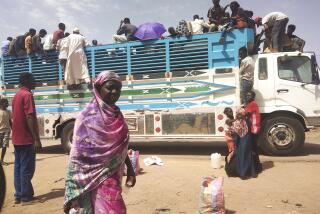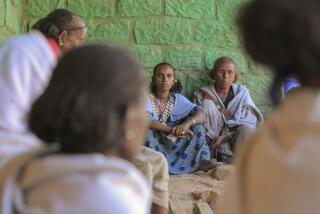Clashes kill 5 when shoppers riot in Mogadishu
- Share via
MOGADISHU, SOMALIA — Thousands of angry Somalis rioted Monday over rising food prices and the collapse of the nation’s currency, culminating in clashes with government troops and armed shopkeepers that killed at least five protesters, witnesses and officials said.
Shops and markets throughout Mogadishu quickly shut their doors as protesters, including many women and children, stoned storefronts and chanted slogans accusing traders of cheating them.
“I’ve never demonstrated before, but I’m not ashamed because if you can’t eat, you will do whatever you can,” said Abdullahi Mohammed, 57, of Mogadishu. “Before I was eating three times a day, but now sometimes it’s not even once.”
Somalia’s beleaguered population is already coping with a civil war that began with the collapse of the government in 1991. But recently, the Horn of Africa nation’s food industry, which previously thrived thanks to private traders, has been grappling with soaring inflation, spurred by an explosion of counterfeit currency over the last year and the global rise in food prices. Somalia imports at least 60% of its grain, and its local crops this year were devastated by a cycle of drought and flooding.
As a result, prices for rice, maize, sorghum and other cereals are up between 100% and 400% over the last year. A sack of rice that sold for $32 only one month ago is now going for $52.
At the same time, the nation’s currency, the shilling, has lost half its value against the U.S. dollar over the last year, requiring consumers to carry sacks of money just to buy common grocery items.
Somalia joins a growing list of African countries where rising food prices have led to violence, including Cameroon, Burkina Faso and Egypt.
Monday’s riots followed a smaller outbreak in Mogadishu, the capital of Somalia, last month. Around the same time, rioters also looted two World Food Program trucks in the city, apparently encouraged by a local government official who announced on the radio that people should vent their frustration against the WFP convoy rather than steal from local shops. The stolen food was eventually returned to the WFP with a government apology, according to a spokesman for the program.
In recent days, unrest returned when shop owners, who had already been pressuring customers to pay in dollars, said they would no longer accept old, worn-out shillings.
Consumers blame traders for exploiting the current crisis, but retailers insist their own suppliers will no longer accept Somalia’s older bills, some of which date back to before 1991.
“I can’t accept the old money because I can’t use it to buy products again from my wholesalers,” said Obey Mahad, who runs a food shop in the capital.
Traders fault the government for failing to address the violence and lawlessness that have driven hundreds of importers to flee the country, and for doing nothing to stop the printing of fake currency. Critics say government officials may even be linked to the counterfeiting rings.
“The government is sitting around and not doing anything,” said one aid worker who asked not to be identified because of safety concerns. “This crisis is weakening the government further and further every day.”
The U.N.-recognized transitional government is barely holding on to power, supported by thousands of Ethiopian troops who in 2006 helped it topple an Islamist regime that controlled Mogadishu.
During a news conference Monday, Mogadishu Mayor Mohammed Dheere blamed the riots on traders and ordered them to accept all bills.
“They have almost all of the money in the country,” Dheere said. “And they [feel they] can just refuse whenever they want and accept whenever they want.”
The U.S. government, which supports the presence of Ethiopian troops in Somalia, views the ongoing instability as a threat to global anti-terrorism efforts.
Last week, the U.S. military killed a top Islamist leader with alleged links to Al Qaeda during an airstrike in central Somalia.
Even before the food and currency crises, aid groups had issued stark warnings about an impending humanitarian catastrophe in Somalia. About 2.6 million Somalis, more than one-fourth of the population, are in need of food aid, up 40% since January, according to the U.N. Food and Agriculture Organization. Rising prices are fueling a surge in unemployment among the urban poor, who previously found work selling firewood or doing laundry but now are unable to find even casual labor.
“I’m very worried because Somalia has so many people on the edge,” said Peter Smerdon, spokesman for the World Food Program in Nairobi, which is feeding nearly 2 million Somalis.
“If rising food prices continue, Somalia is going to get hammered. If the government can’t do anything, the question is, can aid agencies step up?”
--
Special correspondent Mohammed reported from Mogadishu and Times staff writer Sanders from Nairobi, Kenya.
More to Read
Sign up for Essential California
The most important California stories and recommendations in your inbox every morning.
You may occasionally receive promotional content from the Los Angeles Times.










